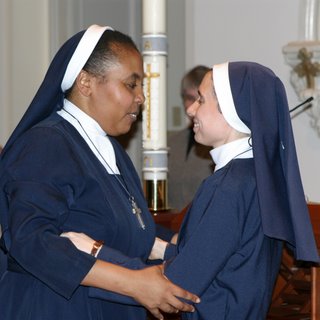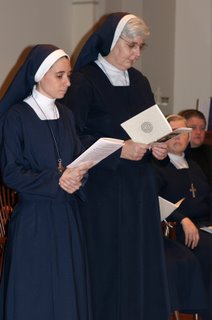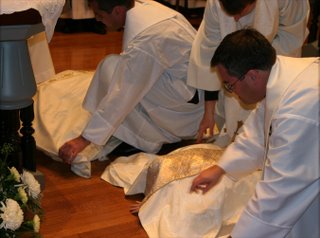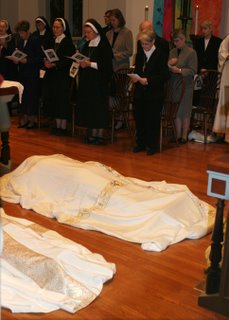Most of our fellow Visitandines in other parts of the world are celebrating the Solemnity of Our Holy Mother, St. Jane de Chantal today. Here in North America, she's been moved to August for the Feast of Our Lady of Guadalupe.
Little by little we are receiving photos from friends and family who were in attendance at the profession on 1 December. We have a few more pictures (at great risk of boring our faithful readers) and a few more customs to share.

Sister Maureen and Sister Anne Elizabeth kneel after their profession for the solemn blessing. Much like our formula for the profession of vows, this blessing has been used for many generations of sisters:
Father in heaven, our desire to serve you is itself your gift.
And our perseverance needs your guiding hand.
How right it is that we should sing your praise.
With boundless love you created the human family through your word, in the Holy Spirit,
And lifted it up into communion with yourself;
You make the human family your bride,
radiant with your own likeness, adorned with gifts of everlasting life.
When your bride, deceived by the evil one, broke faith with you, you did not abandon her.
With everlasting love you renewed with your servant Noah the covenant you had made with Adam.
Then you chose Abraham, the man of faith,
to be the father of a people more numerous than the stars of heaven.
By the hand of Moses you sealed a covenant with them in the tables of the law.
Throughout the ages there arose from this favored people
Holy women renowned for devotion and courage, justice and faith.
In the fullness of time you raised up the Holy Virgin from the stock of Jesse.
The Holy Spirit was to come upon her, and your power was to overshadow her,
Making her the Immaculate Mother of the world’s Redeemer.
He became poor, humble and obedient, the source and pattern of all holiness.
He formed the Church into his bride by loving it with love so great that he gave himself up for it and sanctified it in his blood.
Father, in your loving wisdom, you have singled out many of your daughters to be disciples espoused to Christ and to receive the honor of his love.
Father, we earnestly pray you:
Send the fire of your Holy Spirit into the heart of this, your daughter, to keep alive within her the holy desire He has given her.
Lord, may the glory of Baptism and holiness of life shine in her heart.
Strengthened by the vows of her consecration, may she always be one with you in loving fidelity to Christ, her only Bridegroom.
May she cherish the Church as her mother, and love the whole world as your creation, teaching all people to look forward in joy and hope to the good things of heaven.
Lord, holy Father, guide the steps of your servant and guard her on her pilgrimage though life. When she comes at last to the throne of Christ her King may she not fear him as her judge, but hear the voice of her Bridegroom lovingly inviting her to the wedding feast of heaven.
We ask this through Christ our Lord. AMEN!

One pious practice that our community observes is the tradition of placing prayer intentions in the pockets of those about to be professed. For it is believed that when they prostrate under the pall the prayers are placed before the Lord in a very special way, as the sisters prepare to offer their lives to the Lord. Pictured above is our faithful master of ceremonies, David, adjusting the pall (just in case sister had hopes of breathing!)

The crucifix presented to a sister at her solemn profession is, traditionally, placed on her pillow each morning after she makes her bed. Although it may seem to be an odd place for a crucifix (since our rooms all have one hanging on the wall), the crucifix of profession is a daily reminder of the permanence of our consecration to the Lord, which teaches us to seek no glory but that of his cross.
"For I have chosen and have sanctified this place that my name may be there forever and my eyes and my heart may remain there perpetually."
2 Chronicles 7:16














